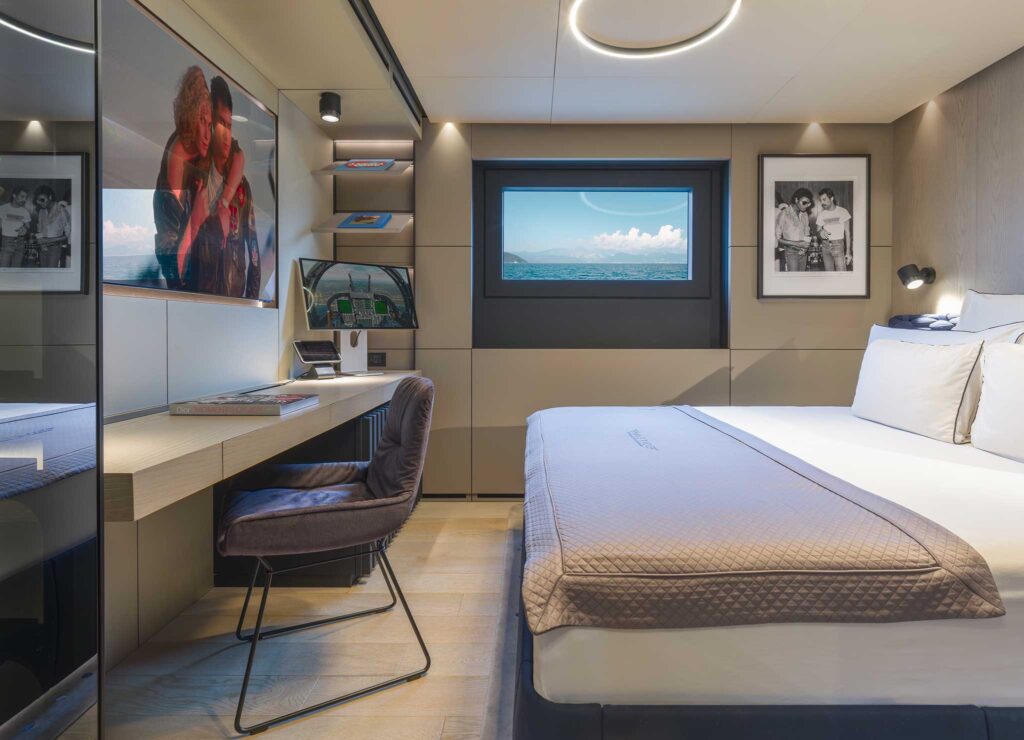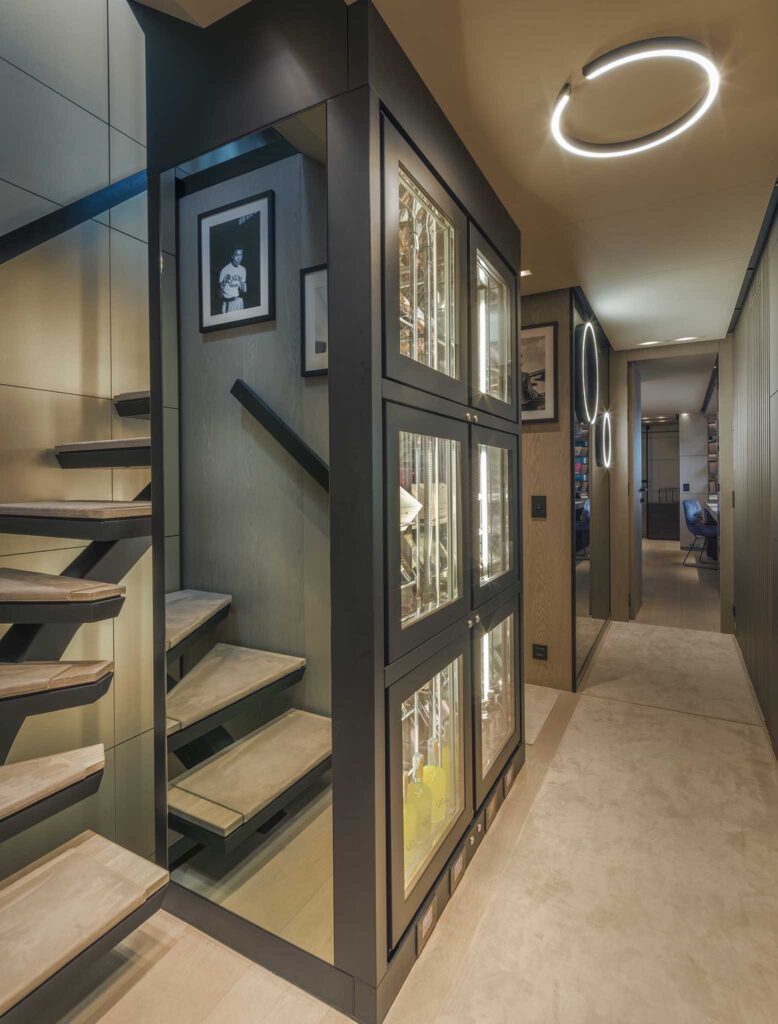Yacht: Flexplorer 146 Maverick

Sales of explorer yachts have surged, driven by younger and more adventurous owners, but only some of these yachts are actually built for real long-distance cruising. Among them are Cantiere delle Marche’s tough, steel-hulled yachts under 500 gross tons. As CEO, sales and marketing director and part owner of the company Vasco Buonpensiere says: “We believe it should be you who sets the limits, not the boat.”
When Tom Schröder first stepped aboard a Cantiere delle Marche yacht at the Cannes Yachting Festival in 2019, he was inclined to agree. A German entrepreneur and Top Gun aficionado with a keen eye for detail, Schröder was struck by the meticulous engineering and technical spaces. “I could see how well everything had been put together, and that impressed me,” he recalls.

That was the moment he knew he wanted a Cantiere delle Marche yacht. A year later, he attended the launch of the 128-foot (39-meter) Aurelia, the first hull in the yard’s Flexplorer series, which aims to redefine what a compact explorer vessel can be. A few months later, Schröder signed a contract for the second Flexplorer, the 144-foot (44-meter) Maverick, which is short for Lt. Pete “Maverick” Mitchell.
Midway through the build, though, Schröder learned that Cantiere delle Marche’s directors were planning a management buyout of the shipyard. He felt inclined to step in.
Schröder learned that Cantiere delle Marche’s directors were planning a management buyout of the shipyard.
He felt inclined to step in.
“I’d built up an excellent relationship with the CdM team,” he says. “Naturally, I did my due diligence—checking the numbers and everything else—but my decision was driven by trust. I believed in their vision, their work and the people behind it.”

Today, Schröder is Cantiere delle Marche’s principal shareholder, but in all other respects, it is business as usual for the boutique shipyard in Ancona on Italy’s Adriatic coast.
“Tom wants to keep it small, family-focused and high quality, because that’s what drew him to CdM in the first place,” Buonpensiere says. “His investment isn’t speculative.”
Maverick is every bit the robust, long-range explorer vessel she was designed to be. The yacht takes the Flexplorer concept, which combines flexibility with functionality, to the next level.

For instance, the open aft deck has been reimagined to maximize space and usability. In the center is a heated pool that can double as stowage for equipment or provisions during long voyages.
The most striking feature is the open aft deck’s A-frame crane, which recesses flush with the teak decking when not in use. Built in lightweight carbon fiber, its lifting capacity of close to 9,000 pounds (about 4,000 kg) can handle substantial tenders and toys, including a 31-foot (9.5-meter) custom tender with an aluminum hull and carbon-fiber topsides.

the lower deck. Maurizio Paradisi
The tender’s name, Iceman, and the smaller jet RIB, Goose, also pay tribute to characters from the Top Gun franchise.
Unlike Aurelia, this yacht has a fourth deck. Maverick’s additional level houses the wheelhouse and captain’s cabin, freeing the upper deck for the owner’s private use. The main deck has a VIP suite forward, while four guest staterooms occupy the lower deck. Above the wheelhouse, a crow’s nest offers panoramic views.
Sergio Cutolo of Hydro Tec, responsible for the yacht’s naval architecture and exterior design, describes Maverick as the ultimate evolution of the Flexplorer series.

“With the increased weight and volume at the bow, we had to rethink the hull form to ensure efficiency and balance,” Cutolo says. “The result is a yacht with a profile reminiscent of offshore support vessels—rugged, capable and undeniably seaworthy.”
Schröder’s ambitions for Maverick include polar exploration and the Northwest Passage. To prepare for such demanding voyages, the yacht has an “ice belt”—a reinforced band of thicker steel plating around the waterline.
Inside, Maverick balances comfort with practicality. The unpretentious interior design is by Francesco Paszkowski. The highly customized layout, which includes an owner’s bathroom that opens onto the aft deck, was modeled around Schröder’s family-oriented lifestyle.

For extended expeditions, the yacht has a walk-in cold room inside the galley, and additional cold and dry stores on the tank deck. A full-height tunnel connects the engine room to the crew quarters.
Power comes from Caterpillar C32 Acert engines, with the shipyard quoting a range of 5,000 nautical miles at a cruising speed of 10 knots. At a time when hybrid propulsion is increasingly common, Cantiere delle Marche decided to stick with conventional engines.
“Explorers need to be reliable above all else,” Buonpensiere says. “Hybrid systems add complexity, and at this scale, the fuel savings simply don’t justify the extra cost. Besides,
Maverick’s fuel consumption is already impressively low: around 70 liters [18 gallons] per hour at 10 knots.”

The yard did include wind power as a sustainable feature. The plan is to equip Maverick with a wing kite system developed by Wingit in Germany. The kite is designed to tow the yacht at low speeds during long transfers, reducing fuel consumption.
Last summer, Maverick embarked on a seven-year global expedition. For Schröder, she is not just a yacht, but a gateway to the world—a vessel built to roam, to discover and to endure.
Fleplorer Maverick
LOA
145ft. 5in. (44.33m)
Beam
28ft. 2in. (8.6m)
Draft
8ft. 8in. (2.7m)
Construction
steel and aluminum
Speed (max./cruise)
14/10 knots
Range
5,000nm @10 knots
Naval Architecture
Hydro Tec
Exterior Design
Hydro Tec
Interior Design
Francesco Paszkowski/Margherita Casprini
Builder
Cantiere delle Marche
For more information: cantieredellemarche.it

Latest News
For Sale! 2016 Sea Ray 350 Sundancer – $180,000
Reel Deal Yacht is pleased to feature a meticulously maintained 2016 Sea...
Paige Bueckers dons cowboy hat in Big D as WNBA No. 1 overall pick formally introduced by Wings
Paige Bueckers has done her best to live in the present during...
UNC hired Bill Belichick to boost its football profile. A game in Ireland marks a return on that bet
Bill Belichick had a quick chuckle as he recalled the unusual practice...
Pistons, Tigers take the baton in Detroit’s pro sports renaissance
With the Lions, Tigers and Pistons — oh my — the Motor...
Judge dismisses lawsuit filed against NBA player Ja Morant over a fight during a pickup game
A judge has dismissed a lawsuit filed by a teenager who accused...














Leave a comment